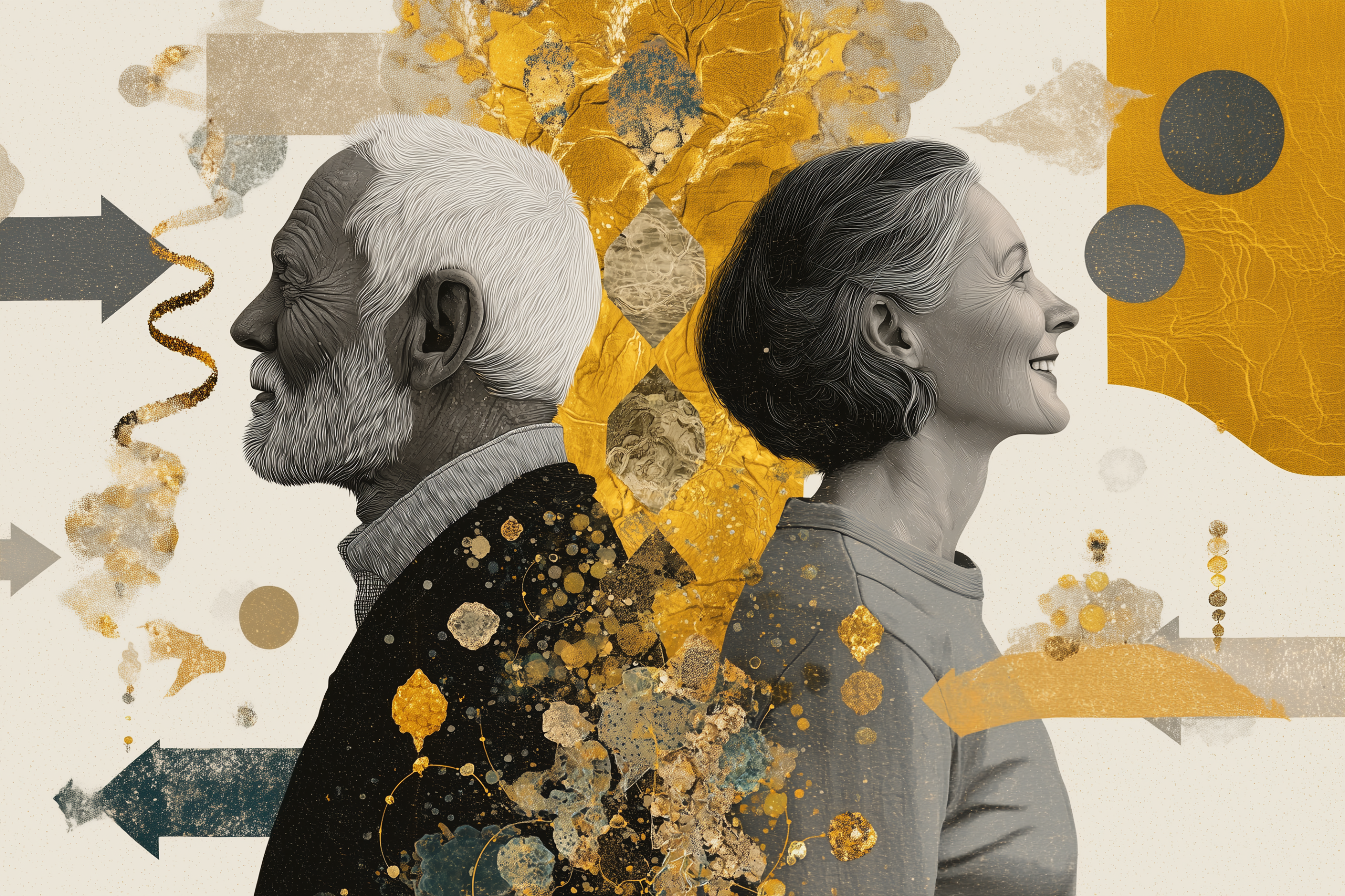A single mother spending $108 monthly is aging slower than the billionaire who spends $2 million a year trying to live forever.
Note: This article is for educational and informational purposes only. See full disclaimer at the end.
The quiet revolution happens not in a lab, but in a Phoenix kitchen at 5 AM, where a single mother prepares vegetables while a billionaire across the country undergoes his 47th medical procedure of the month.
A Tale of Two Approaches
In the race to outlive our biological clocks, two distinct philosophies have emerged. On one end stands Bryan Johnson, the 47-year-old tech entrepreneur who spends $2 million annually on what he calls “Project Blueprint”—a relentless pursuit of biological optimization that involves [12] over 100 daily pills, continuous monitoring by a team of 30 doctors, and a lifestyle so regimented that an algorithm literally decides when he eats, sleeps, and exercises.
On the other end, Julie Gibson Clark, a 55-year-old single mother from Phoenix who makes less than $100,000 a year, is aging at just 0.665 biological years for every chronological year—outperforming Johnson on the very leaderboard he created [1]. Her secret? A $27 gym membership, a $79 monthly supplement subscription, and what she calls simply being “health-conscious.”
The irony is delicious: Clark currently ranks second on the Rejuvenation Olympics leaderboard, while Johnson, despite his millions in investment, sits at number six [6].

Bryan Johnson's Blueprint Revolution
Bryan Johnson doesn’t just track his health—he’s turned his body into the world’s most monitored biological experiment. Every morning at 5:25 AM, he consumes an 8-ounce longevity drink containing precisely measured compounds [14]. His breakfast, eaten at the same time daily, includes a “Super Veggie” mix of broccoli, cauliflower, mushrooms, ginger, and garlic—every ingredient weighed to the gram.
But it’s the depth of his monitoring that truly sets Johnson apart. He tracks over 70 organs, measuring everything from nighttime erections (yes, really) to the speed of his internal aging [15]. His team reviews population-level studies constantly, adjusting his protocol based on the latest science. He’s undergone experimental gene therapy with Follistatin, received 300 million stem cells injected into his joints, and follows a workout routine so precise that his recovery periods are timed to the second.
The results? Johnson claims his biological age markers show he has the cardiovascular system of someone in their 30s, despite being 47. His HRV (heart rate variability) rivals that of elite athletes. His inflammation markers are virtually non-existent. Blueprint’s website boldly states he has “the best biomarkers in the world” and is “the healthiest human on the planet” [13].
Yet here’s what’s fascinating: Johnson doesn’t hoard this information. Every detail of his protocol is freely available online. The man spending millions to crack the longevity code is giving away the blueprint—literally—for free.
Julie Gibson Clark's Accessible Excellence
Julie Gibson Clark’s morning routine sounds almost mundane compared to Johnson’s orchestrated symphony. She wakes between 4:45 and 5 AM—not because an algorithm told her to, but because she enjoys the quiet morning hours [1]. She drinks green tea, meditates, says a prayer, and then drops her 17-year-old son off at school before heading to the gym.
Her workout? A balanced mix of strength training twice weekly, one VO2 max session using Norwegian 4×4 intervals, and regular cardio. No team of trainers. No biometric feedback devices strapped to every limb. Just consistent, purposeful movement.
Clark consumes about 16 ounces of vegetables daily—not because she’s following a strict protocol, but because she genuinely enjoys them [9]. She snacks on carrots, radishes, and peppers during her workday as a recruiter. She practices intermittent fasting, typically eating within a 6-8 hour window, and uses the sauna three times a week followed by cold showers.
Her supplement routine is refreshingly simple: NOVOS Core and Boost, providing targeted longevity compounds without the pharmaceutical complexity of Johnson’s regime [1]. Total monthly cost: $108.
But here’s the crucial insight: Clark doesn’t see any of this as biohacking. “I don’t like that term,” she says. “This stuff has to just kind of be like brushing your teeth” [8].

Attia and Sinclair's Evidence-Based Middle Ground
Between Johnson’s extremism and Clark’s pragmatism lie the physician-scientists who’ve dedicated their careers to understanding longevity. Dr. Peter Attia and Dr. David Sinclair represent the clinical translation of longevity science—taking laboratory discoveries and turning them into practical protocols.
Dr. Peter Attia, a Stanford and Johns Hopkins-trained physician, has developed what he calls the “Centenarian Olympics”—training for the physical tasks you want to be able to do at 100 [5]. His framework rests on four pillars: stability, strength, aerobic efficiency (Zone 2 training), and anaerobic performance (VO2 max work).
Attia’s approach is ruthlessly practical. He prescribes four 45-60 minute Zone 2 cardio sessions weekly—exercise performed at 65-75% of maximum heart rate where you can still maintain a conversation [17]. This isn’t sexy or extreme; it’s the cardiovascular equivalent of compound interest, building mitochondrial efficiency that pays dividends decades later.
For VO2 max, Attia uses the 4×4 protocol: four minutes of maximum effort followed by four minutes of recovery, repeated four to six times [2]. Again, nothing revolutionary—just consistent application of proven physiology.
Meanwhile, Dr. David Sinclair at Harvard has spent decades studying the molecular mechanisms of aging. His daily protocol centers on boosting NAD+ levels and activating sirtuins—the cellular pathways that appear to control aging [3]. He takes 1 gram of NMN (nicotinamide mononucleotide) each morning, 1 gram of resveratrol mixed with yogurt for absorption, and has recently added spermidine for autophagy activation.
What’s remarkable about Sinclair is his evolution. He started his anti-aging protocol at age 30, simply by skipping breakfast and limiting sugar [18]. Now at 54, he claims his biological markers resemble someone decades younger. He practices 16-18 hour intermittent fasting daily, believing that “three meals a day plus snacks puts the body in a state of abundance, which turns off our longevity genes.”
The Common Threads
Despite their vastly different approaches and budgets, these longevity leaders share surprising commonalities:
Movement as Medicine: Whether it’s Johnson’s algorithm-directed workouts, Clark’s morning gym sessions, or Attia’s Zone 2 training, they all prioritize consistent, purposeful exercise. Not extreme exercise—purposeful exercise.
Metabolic Control: Every single leader practices some form of eating window restriction. Johnson stops eating by 11 AM. Clark fasts for 16 hours. Sinclair skips breakfast entirely. They’ve all independently concluded that when you eat matters as much as what you eat.
Temperature Stress: From Clark’s sauna and cold showers to Johnson’s precisely controlled cold exposure, they all use temperature variation to trigger hormetic stress—the kind of controlled challenge that makes the body stronger.
Sleep Sanctity: Johnson uses an Eight Sleep temperature-controlled bed and is asleep within three minutes of his head hitting the pillow at 8:30 PM. Attia aims for 7-8 hours nightly and tracks it religiously [14]. Clark maintains consistent sleep-wake times. They all treat sleep as non-negotiable.
Data-Driven Decisions: Even Clark, with her modest budget, submitted samples for epigenetic testing to understand her biological age. They all measure to manage.

The Uncomfortable Questions
But here’s where the story gets complicated. When we look closer at these protocols, uncomfortable questions emerge.
Johnson’s extreme approach has transformed him into something that looks more like a walking laboratory than a human being living a full life. His former self—the one he calls “Evening Bryan” who used to overeat—has been completely eliminated, replaced by algorithmic decision-making [16]. Is this optimization or a different kind of prison?
Sinclair’s advocacy for NMN became controversial when he successfully lobbied the FDA to reclassify it as a medicine while his pharmaceutical company researched it, frustrating the longevity community who had been using it as a supplement [19]. When the prophet has profit motives, how do we evaluate the prophecy?
And what about reproducibility? Clark’s results are remarkable, but she started her serious health journey after being diagnosed with heavy metal poisoning—a crisis that forced dramatic lifestyle changes. Can her results be separated from her unique circumstances? [7]
What Actually Works: Universal Principles
When we strip away the extremes, the personalities, and the price tags, certain principles emerge that appear universal across all successful longevity protocols:
The Foundation Is Free: The most powerful interventions—exercise, fasting, sleep, and stress management—cost nothing. Clark proves you don’t need millions to slow aging; you need consistency [10].
Muscle Matters More Than Molecules: Every leader prioritizes strength training. Attia calls it the most potent longevity “drug.” Clark does it twice weekly. Johnson’s algorithm demands it daily. The message is clear: maintain muscle mass or lose life quality.
Stress Without Distress: Whether through exercise, temperature exposure, or fasting, all these protocols involve controlled challenges that trigger adaptation without causing damage. The dose makes the medicine.
Consumption Windows: It’s not just what you eat but when you don’t eat that matters. Every successful protocol includes significant periods of not consuming calories.
Measurement Enables Management: You don’t need Johnson’s 70-organ monitoring system, but you need some objective measures of progress. Even basic blood work provides actionable insights.

The Accessible Path Forward
So what can the average person actually implement today? Here’s what the evidence suggests:
Start with Movement: Aim for 150 minutes of Zone 2 cardio weekly—that’s just 30 minutes, five days a week, at a pace where you can maintain conversation. Add two strength training sessions. This alone, according to Attia, provides 75% of the longevity benefits available from all interventions combined [4].
Create an Eating Window: Start with 12 hours of fasting (say, 7 PM to 7 AM), then gradually extend to 14-16 hours as comfortable. This simple practice activates many of the same pathways as expensive supplements.
Prioritize Protein and Vegetables: Clark’s pound of vegetables daily and adequate protein intake (she aims for significant amounts at each meal) provide the micronutrients and building blocks for cellular repair without any exotic compounds.
Add Temperature Variation: A cold shower doesn’t require a mortgage payment. Three minutes of cold exposure at the end of your regular shower provides significant benefits. If you have access to a sauna, use it. If not, a hot bath followed by cold exposure works too.
Consider Basic Supplementation: If budget allows, the most evidence-based additions are Vitamin D3 (4,000-5,000 IU daily), Omega-3 fatty acids, and magnesium. For those wanting to explore further, NMN or NR for NAD+ support shows promise, though the long-term human data is still emerging.
The Paradox of Progress
Perhaps the most profound insight from studying these longevity leaders is that the gap between the $2 million protocol and the $108 monthly routine is much smaller than we might expect. Clark, spending 1/18,500th of Johnson’s budget, achieves comparable or better results on the very metrics Johnson created [11].
This suggests something important: beyond a certain threshold of basic interventions, the returns diminish dramatically. The difference between doing nothing and doing something is massive. The difference between doing something and doing everything might be marginal.

The Real Revolution
The true revolution isn’t in Johnson’s Blueprint or Sinclair’s supplements or even Clark’s remarkable results. It’s in the democratization of longevity science. When a single mother can access the same biological age testing, implement evidence-based protocols, and achieve results that rival billionaire biohackers, we’re witnessing a fundamental shift in human potential.
The pioneers aren’t just showing us what’s possible with unlimited resources—they’re inadvertently proving that the most powerful interventions are accessible to almost everyone. The question isn’t whether you can afford to invest in longevity. It’s whether you can afford not to.
Because while Bryan Johnson is spending millions to live forever, Julie Gibson Clark is proving that the fountain of youth might actually be a water fountain at the local gym.
The race to reverse aging isn’t being won by the biggest spender or the most extreme protocol. It’s being won by consistency, by treating health optimization as a daily practice rather than a heroic quest. As Clark puts it, longevity isn’t about biohacking—it’s about making healthy choices as routine as brushing your teeth.
The leaders have shown us the paths. The extreme, the accessible, and everything in between. The choice of which path to walk—that remains uniquely yours.
See you in the next insight.
Comprehensive Medical Disclaimer: The insights, frameworks, and recommendations shared in this article are for educational and informational purposes only. They represent a synthesis of research, technology applications, and personal optimization strategies, not medical advice. Individual health needs vary significantly, and what works for one person may not be appropriate for another. Always consult with qualified healthcare professionals before making any significant changes to your lifestyle, nutrition, exercise routine, supplement regimen, or medical treatments. This content does not replace professional medical diagnosis, treatment, or care. If you have specific health concerns or conditions, seek guidance from licensed healthcare practitioners familiar with your individual circumstances.
References
The references below are organized by study type. Peer-reviewed research provides the primary evidence base, while systematic reviews synthesize findings.
Government / Institutional Sources
- [1] NOVOS Labs (2024). Julie Gibson Clark Longevity Journey. https://novoslabs.com/julie-gibson-clark-longevity-journey/
Industry / Technology Sources
- [2] NAD.com (2024). Dr. Peter Attia’s VO2 Max Protocol and Heart Health Supplements for Longevity. https://www.nad.com/news/dr-peter-attias-vo2-max-protocol-and-heart-health-supplements-for-longevity
- [3] NAD.com (2024). David Sinclair’s 2024 Anti-Aging Supplement Protocol. https://www.nad.com/news/david-sinclairs-2024-anti-aging-supplement-protocol
- [4] Peter Attia, M.D. (2024). Exercising for Longevity. https://peterattiamd.com/category/exercise/
- [5] Fitnescity (2024). Dr. Peter Attia’s Longevity Protocol: Everything You Need to Know. https://www.fitnescity.com/blog/dr-peter-attias-longevity-protocol-everything-you-need-to-know
- [6] NAD.com (2023). Gender Dynamics in the Longevity Market. https://www.nad.com/news/gender-dynamics-in-the-longevity-market-one-woman-triumphing-over-men-with-budget-friendly-anti-aging-solutions
- [7] Acast (2024). You Don’t Need Millions to Slow Aging | Julie Gibson Clark. https://shows.acast.com/social-wellness/episodes/julie-gibson-clark
- [8] Fortune (2024). Tech bros like Bryan Johnson are spending millions to shoot for immortality. https://fortune.com/well/2023/11/04/longevity-women-biohackers-diet-exercise-bryan-johnson/
- [9] Fortune (2024). This 55-year-old single mom makes less than $100k per year and is reverse aging. https://fortune.com/well/article/reverse-aging-habits-daily-routine-single-mom-budget/
- [10] The Longevity Newsletter (2023). Julie Gibson Clark, world-class Rejuvenation Olympian. https://www.thelongevitynewsletter.com/p/julie-gibson-clark-rejuvenation-olympics
- [11] The Purist (2024). Rejuvenation Olympics And The Race To Turn Back Time. https://thepuristonline.com/2024/05/rejuvenation-olympics-and-the-race-to-turn-back-time/
- [12] Bryan Johnson (2024). Blueprint Protocol. https://protocol.bryanjohnson.com/
- [13] Blueprint Bryan Johnson (2025). Blueprint Official Website. https://blueprint.bryanjohnson.com/
- [14] Blueprint Bryan Johnson (2024). Blueprint Protocol Details. https://blueprint.bryanjohnson.com/pages/blueprint-protocol
- [15] Routines Club (2025). The Bryan Johnson Blueprint Protocol. https://routines.club/routine/bryan-johnson-blueprint-protocol
- [16] Augment Life (2024). The daily anti-aging routine of Bryan Johnson – Project Blueprint. https://augmentlifeshop.com/blogs/extending-healthy-lifespan/the-daily-anti-aging-routine-of-bryan-johnson-project-blueprint
- [17] Hone Health (2025). Peter Attia’s Workout Routine: How to Workout to Live Longer. https://honehealth.com/edge/peter-attia-workout-routine/
- [18] Routines Club (2025). David Sinclair’s Daily Routine in 2025. https://routines.club/routine/david-sinclairs-daily-routine-for-longevity
- [19] Human People (2025). Understanding Professor David Sinclair’s Longevity Supplement Regimen. https://humanpeople.co/blogs/blog/understanding-professor-david-sinclairs-longevity-supplement-regimen-the-role-of-nmn-co-enzymes-phytopharmaceuticals-vitamins-and-more


